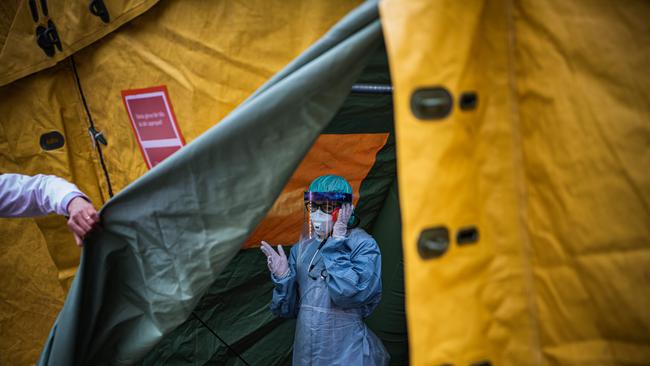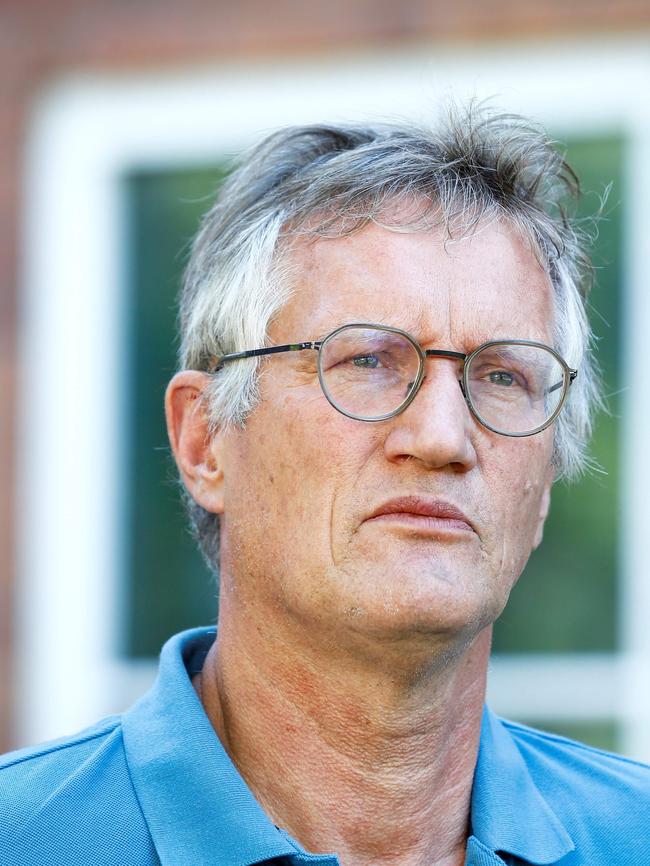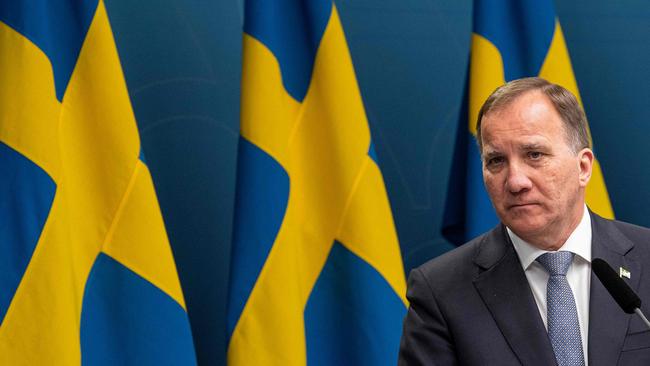As coronavirus bites, Sweden gets a lesson in isolation
The self-confident country that scorned a lockdown has gone, replaced by one that doubts itself and its leader.

The bells of St Olof’s clanged as the mourners filed out into the afternoon sunshine. By the side of the red-painted wooden chapel, Susanna Tegberg, the pastor, sat in the shade of a birch tree with a book of psalms. She had just finished a funeral service for a 90-year-old parishioner, and had been unable to hug or comfort the family.
A few hundred feet away, on the beach, a party was in full swing. It was 29C and blonde girls in bikinis crammed together in a queue for ice cream as muscle-bound teenage boys worked on their tans. The church bells were just audible over the music from their speakers.
It was another strange day in my childhood hometown, Halmstad, where I’ve had to sit out the global pandemic. While here, I’ve seen Sweden’s reputation go from being a friendly beacon of social democracy to an outcast whose refusal to lock down has been blamed for causing nearly 5,300 deaths in a population of 10.2 million.
Unlike Turkey, where I usually live as this newspaper’s Middle East correspondent, Sweden is even being refused a quarantine exemption by Britain because its infection rate is still too high.

Four months ago, things were very different. It was early spring, the wind was freezing and the beach crunched with ice. I had just arrived from Iran, where I’d been reporting on parliamentary elections when the virus erupted there.
Borders — including Turkey’s — were slamming shut but I managed to reach my parents’ home in Halmstad, crossing the Oresund bridge from Denmark to Sweden just before it closed.
I went into self-isolation in the cottage next door to St Olof’s chapel, watched Wallander on television and politely refused the wool leggings pressed on me by my (Swedish) mother, as well as the pickled herring.
I thought I’d only be there for a few weeks. In fact, it would be the longest time I’ve spent back in Sweden since my family left Halmstad for the UK when I was six.
As the days warmed and I emerged from my post-Tehran self-isolation, it became clear that Sweden was not going to follow Denmark, Norway, Britain or anywhere else in imposing lockdowns.
The state banned large gatherings, and advised people to stay at home if they showed symptoms of Covid-19. But bars and restaurants stayed open — with some restrictions — as did schools for under-16s, hairdressers and clothes shops.
Swedes would be trusted to make the right choices, said the state epidemiologist, Anders Tegnell, who became the face of the pandemic.
My grandmother started isolating, some friends went part-time at work, but everything else seemed exceedingly normal. Some scientists complained about the laissez-faire approach, but the public mood was — from where I was standing one — of blissful self-satisfaction.
There was a real sense of exceptionalism: that we were different from other countries. The French, several people told me, might have to be forced to stay home, but we were obedient people who could be trusted to do as we were told.
It was exactly the kind of smug, self-righteous Swedish attitude that sends our neighbours mad. For a lot of Danes and Norwegians, the most populous country in Scandinavia is arrogant, inflexible and obsessed with its own superiority.

Sometimes, it’s hard not to agree with this criticism — particularly when, in Stockholm a couple of weeks after we were entrusted to make the right choices, I saw bars packed with sweaty, gleeful people celebrating the arrival of spring with buckets of prosecco.
“Oh, someone told me you guys are taking this whole thing seriously,” laughed a friend I bumped into outside the hairdressers. He was referring to my (British) dad, aged over 70, who was turning down dinner party invitations and using hand sanitiser.
It was frustrating but of a piece with the happy bubble much of Sweden lives in. By being born in this country, you’ve won the lottery. You’re likely to live longer, be healthier and richer than the vast majority of people in the world. If you’re ill, you get treated free by a highly trained doctor. You can go to most other countries with no trouble at all, and when you get there people will tell you how great they think Sweden is.
So when things started going wrong, it was a genuine shock for many. The death rate began to climb steadily, then very fast, eclipsing Denmark and Norway as the virus wormed its way into our nursing homes. Claims by Swedish officials that we would hit herd immunity by summer turned out to be complete fantasy. People around the world lampooned Swedish policies. Denmark and Norway closed their borders to us; then Greece, the Czech Republic and others did so.
“It’s crazy how people don’t like us any more,” half-joked one 19-year-old art student while we sat at a bar in Malmo. “We miss Denmark. Let us come back. We’re sorry.”
Others were furious, and felt unfairly attacked. Last week, after the World Health Organisation classified Sweden as an at-risk country with rising infections - putting us in the same group as Azerbaijan and Albania - Tegnell told Swedish radio that it was a “total misinterpretation” of the data, and that the increase in infections was a result of improved testing. Yesterday he announced a big new contact-tracing initiative.
Every week there’s new mudslinging. Yet in Halmstad, it mainly feels like nothing at all is happening. This is a disease that thrives in clusters, and our region - deep in the south - has so far got off relatively lightly: 1,271 registered infections and 66 deaths.
A friend who works in an office said he often forgot about the pandemic completely. This month, I went on holiday in the western archipelago and realised after a week that not a single person had mentioned the virus to me. The ice cream stands were packed, the bars open, the buckets and spades flying off the shelves.
In Stockholm, it’s a different story. More than 2,285 people have died and almost 20,000 have been infected. But it also depends on where you live. The Old Town — usually rammed with tourists — is empty. In the trendier quarters to the south, life for many goes on as normal. The bulk of casualties are in the suburbs - places such as Rinkeby, where 59 per cent of the population was born abroad.
Several ethnic minority communities have been devastated by the virus. An Assyrian who had lived in Sweden for seven years told me he was terrified of the disease, which had killed 43 people in his 150,000-strong community — a wildly disproportionate number. Sweden had been a sanctuary for them, until it wasn’t.
A teacher working in a disadvantaged area told me that many students from ethnic minority backgrounds had been absent since the pandemic began. Their parents, the teacher said, just didn’t trust the Swedish approach.
The scepticism isn’t limited to immigrant communities. Slowly, the trust in institutions and leaders that is the bedrock of the Swedish state is being eroded. Stefan Lofven, the prime minister — a member of the Social Democrats, the party that created the Swedish welfare state — has seen his approval rating fall by 10 per cent this month.
People compare their current uncertainty to the feeling after the refugee crisis of 2015, when more than 160,000 asylum-seekers came to Sweden — stretching public services and leaving many voters worried that their country was changing in a way they hadn’t bargained for.
Yet many are still cautiously positive about Tegnell’s message, delivered constantly over the airwaves, that we can draw no conclusions yet, that other countries may suffer more than us from economic and social damage or a second wave.
While public support for the state epidemiologist has wavered, he still has the confidence of 60 per cent of the population. In an interview a few weeks ago, he told me that he stood by the no-lockdown plan, and that other countries should have had ice in their stomach - a very Swedish metaphor — rather than panicking and shutting down.
Before Covid-19 began, he said, all the Nordic countries had pandemic plans that looked like Sweden’s. When the crisis began and our neighbours ripped up the strategy and locked down, he had been shocked.
To my Norwegian and Danish friends, this was further proof of our inflexibility. To Tegnell, it was principled. Closing borders, he said, was pointless. To have saved lives, the state should have worked harder to protect the vulnerable elderly.

In these last few months, I’ve watched Sweden’s strategy become a sort of Rorschach inkblot test. Libertarians see the laissez-faire approach as freedom from state tyranny. Others insist that the refusal to lock down amounted to a state massacre.
That’s how Jimmie Akesson, leader of the far-right Sweden Democrats, described what happened in nursing homes, where more than half of Sweden’s Covid-19 deaths occurred. The virus, he said, was allowed to spread through colossal misjudgment from the state, killing as it went. A survey in the Stockholm area indicated that it was not quite that simple, and that the main issues were basic hygiene procedures, difficulties in isolating infected residents and a shortage of qualified staff.
While deaths in Sweden dwarf those in Denmark and Norway, they are not much higher - adjusted for population - than those in France, which locked down in mid-March, and are below those in Britain. And while GDP is set to decline by 6.5 per cent, according to SEB, one of the country’s biggest banks, the predictions for the economy are much more positive than for the UK or France.
Back in Halmstad, Tegberg has reintroduced church services, seating worshippers as far apart as possible in the pews. Many of the older members of her congregation are still too afraid to attend so she’s started posting her sermons online and gets hundreds of views, far more than the few dozen people who used to come to church on a Sunday.
“The hardest part is not being able to touch someone’s arm when they’re sad, or let them hug you,” she said. “People need human contact. It would have been even more difficult to maintain that if we had locked down.”
Yesterday, Denmark opened the border for Swedes from areas with low infection rates — Halmstad included.
I hope that in the next few days I’ll be able to take the road back over the bridge to Copenhagen that I drove down four months ago and fly to Istanbul.
I’ll be leaving behind a country that has changed forever: a little less sure of itself, its happy protective bubble burst.
The Sunday Times



To join the conversation, please log in. Don't have an account? Register
Join the conversation, you are commenting as Logout